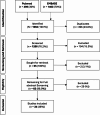Neutrophil cell surface receptor dynamics following trauma: a systematic review
- PMID: 40788542
- PMCID: PMC12339592
- DOI: 10.1007/s00068-025-02937-0
Neutrophil cell surface receptor dynamics following trauma: a systematic review
Abstract
Purpose: Neutrophils are essential effector cells in the immune response to traumatic injury. Although changes in receptor expression over time have been described in the literature, effective monitoring strategies are still lacking. This systematic review aims to identify reported neutrophil cell surface receptor dynamics after trauma and to determine the post-traumatic neutrophil signature over time, forming the basis for future immunomonitoring.
Methods: We conducted a systematic review to identify clinical studies describing neutrophil cell surface expression levels of relevant markers in the field of trauma. Reported post-traumatic alterations were gathered and pooled.
Results: A total of 1,266 publications were identified that used neutrophil phenotype in a clinical setting, of whom 34 were utilized for data extraction. The most frequently analyzed receptors were Mac-1/CD11b (n = 25), L-selectin/CD62L (n = 9). Fifteen studies investigated the Fcγ-receptor family. CD11b increases after moderate to severe trauma, peaking at 24 h, then decreases over 6 months. L-selectin shows early fluctuations, whereas CD16 decreases homogeneously after trauma. CD64, as well as other less well-described markers (CD13, CD46, CD55, CD59) show homogenous alterations following injury.
Conclusions: This study is the first comprehensive review on post-traumatic neutrophil receptor dynamics. By pooling available data from literature, a unique multi-parameter post-traumatic neutrophil signature, with both traditional neutrophil markers (CD11b, CD11a, CD62L, CD16, CD64) and novel markers has been identified. Future combining of these markers and subset analysis may form the basis for post-traumatic immunomonitoring.
Supplementary Information: The online version contains supplementary material available at 10.1007/s00068-025-02937-0.
Keywords: Cell surface markers; Immunomonitoring; Neutrophil activation; Neutrophils; Polytrauma; Post-traumatic immune response; Systematic review; Trauma.
Conflict of interest statement
Declarations. Ethics approval and consent to participate: Ethical approval was not necessary. The patient gave informed consent to participate. Consent to publish: The authors confirm that informed consent was obtained from the patient for publication of this case report. Competing interests: The authors declare no competing interests.
Figures
References
Publication types
LinkOut - more resources
Full Text Sources
Research Materials
Miscellaneous



